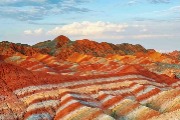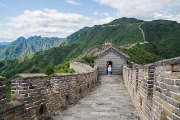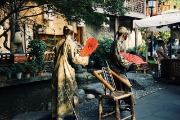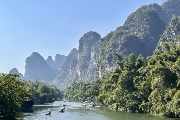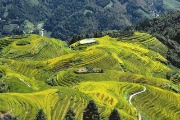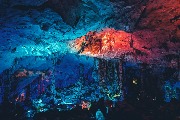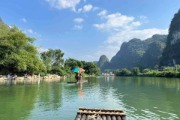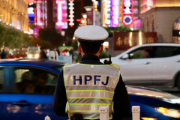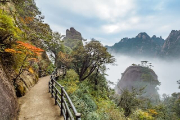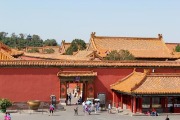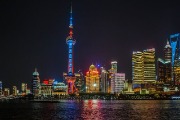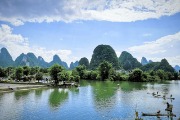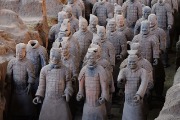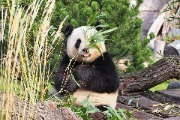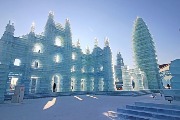Longji Rice Terraces
You’ve probably seen rice fields, but you’ve definitely never seen rice fields that cover an entire mountain.

The Longji Rice Terraces (龙脊梯田), also known as the Longsheng Rice Terraces (龙胜梯田), are located in a mountainous area with layers of terraced fields stretching across the landscape. As the seasons change, the scenery here transforms, offering different views throughout the year. The forest and terraced fields are in a 2:1 ratio, with the forests covering much of the land, making the mountains a natural reservoir. The area is home to two major ethnic minorities, the Zhuang and the Yao, who still maintain many of their traditional customs and architectural styles.
When visiting the Longji Rice Terraces China, tourists can deeply experience local culture and customs. For example, in the Jinzhu Zhuang Village, visitors can take part in various farm activities like catching chickens, collecting eggs, making rice cakes, fishing, picking vegetables, and harvesting fruits. The ingredients gathered can then be used to prepare delicious local Zhuang dishes. Additionally, visitors can enjoy unique local foods, such as bamboo chicken, bamboo rice, Longji glutinous rice wine, five-colored sticky rice, dried bamboo shoots, and rice cakes.
After Qingming and Grain Rain festivals each year, the villagers engage in a series of agricultural activities, like clearing the fields, planting, and weeding. These activities are often accompanied by local festivals such as the Plowing Festival, the Seedling Festival, and the Clothes Drying Festival.
Table of Contents
Scenery of Longji Rice Terraces
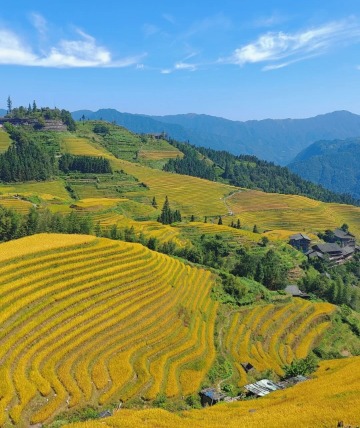
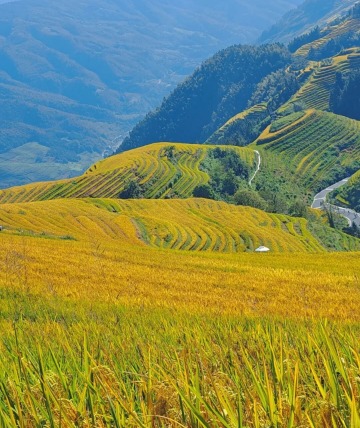
Xishan Shaole
Xishan Shaole is located at the highest point of the Longji Rice Terraces China. The view here is breathtaking, offering a panoramic look at the terraced fields below. The terrain is quite steep, so walking up the mountain requires some stamina. But the scenery along the way makes it all worthwhile. Xishan Shaole is especially beautiful at sunrise, making it a photographer’s paradise.
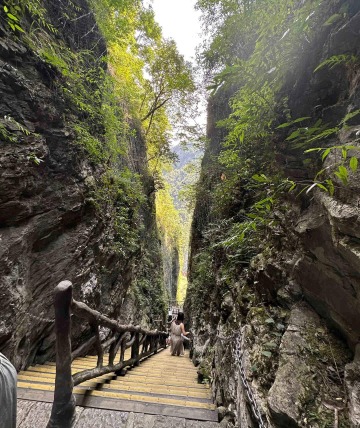
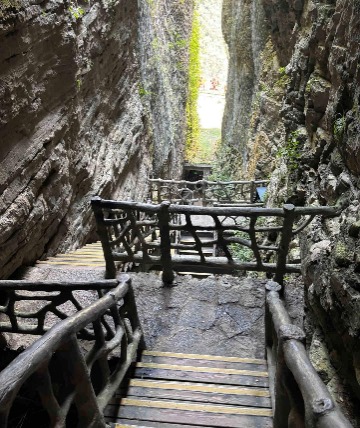
Golden Buddha Peak
Near Golden Buddha Peak, you’ll find traditional Yao architecture and decorations. Visitors can rent traditional Yao costumes and experience the unique culture and lifestyle of the Yao people. You can also visit nearby Yao villages to learn about their traditional crafts and enjoy authentic Yao cuisine.
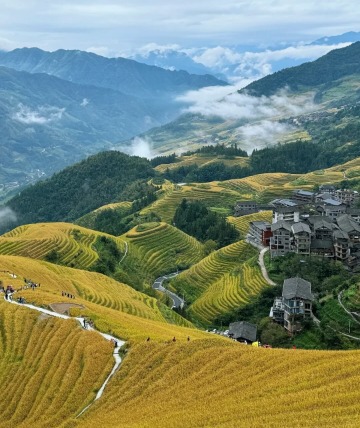
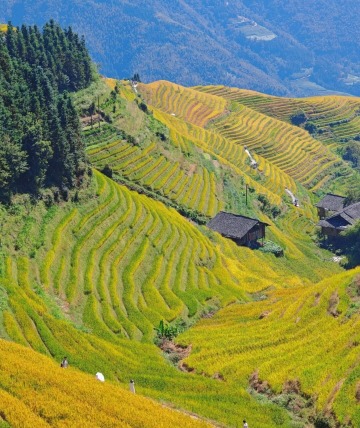
Nine Dragons and Five Tigers
The Nine Dragons and Five Tigers viewpoint is located in the Ping’an Zhai area of the Longji Rice Terraces. “Nine Dragons” refers to nine small ridges that branch off from the main Longji ridge. “Five Tigers” refers to five small peaks, each surrounded by terraced fields.
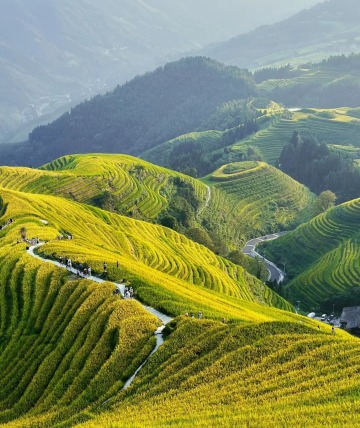
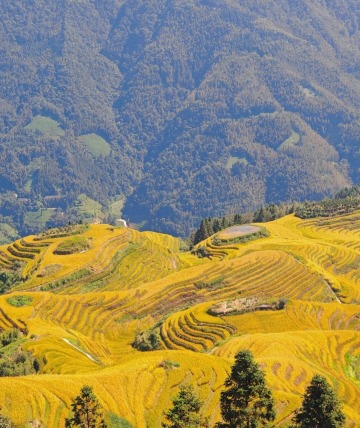
Seven Stars Accompanying the Moon
Seven small peaks surround a larger one, much like seven stars around the moon. From here, you can enjoy an uninterrupted view of the terraced fields. In the spring, when the fields are flooded with water, the terraces shine with a silvery glow, reflecting the surrounding green hills and creating a stunning pastoral scene. Near the Seven Stars Accompanying the Moon viewpoint, visitors can experience local ethnic customs and unique features. You’ll see traditional houses, lush vegetation, stone paths, businesspeople at ease, and children playing. There are also many local snacks and handicrafts available, such as chicken blood jade, licorice fruit, monk fruit, and various mushrooms.
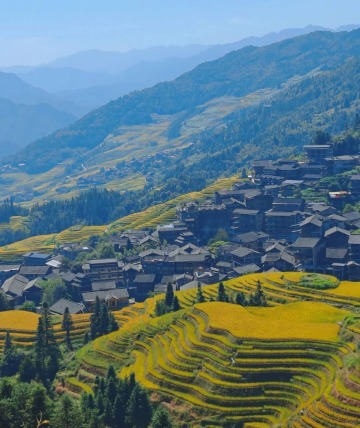
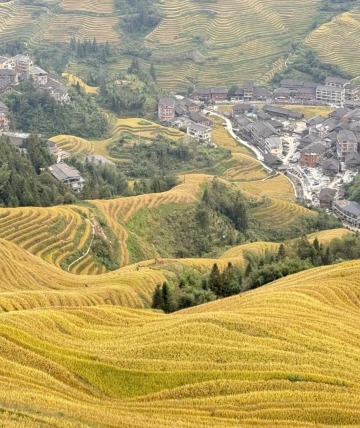
Ancient Zhuang Village
The Ancient Zhuang Village is located on the outskirts of the Longsheng Rice Terrace Guilin. If you want to experience the most authentic terrace views, this is a great choice. The village has preserved traditional Zhuang customs and lifestyle, offering visitors a chance to learn about Zhuang history and culture. The unique stilted houses are built into the hillside, blending seamlessly with the terraced fields.
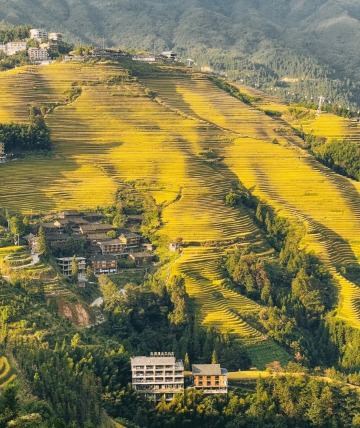
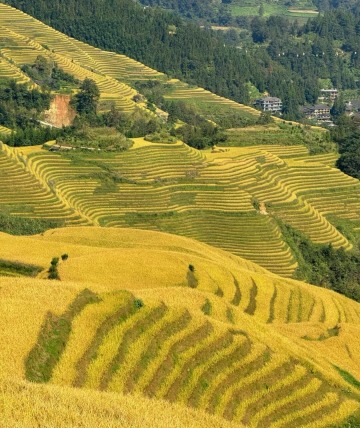
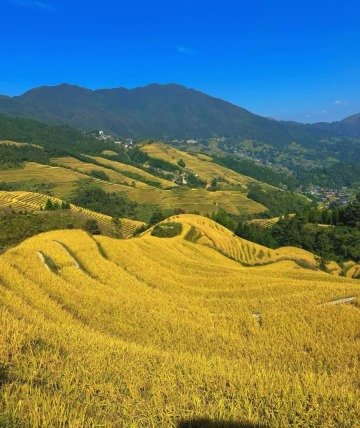
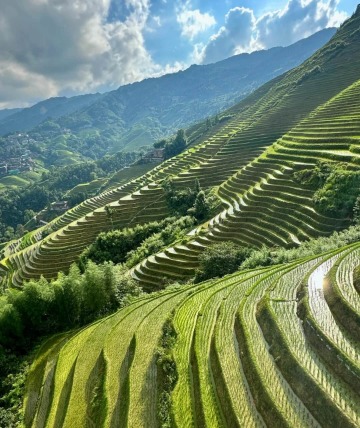
Thousand-Step Ladder
The Thousand-Step Ladder of the Longsheng Rice Terrace winds its way from the foot of the mountain to the top. The highest point has over 1,100 steps, earning it the title of “The Crown of the Rice Terrace World.”
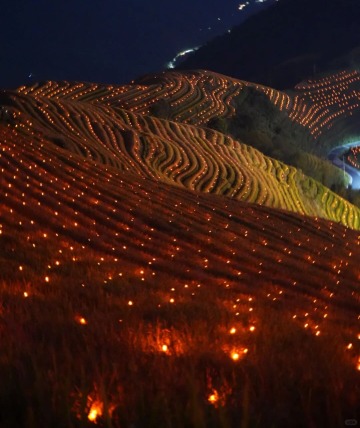

Night Views
At night, rows of torches and lights line the terraces, casting a soft glow. It feels like a river of stars has fallen to the ground, blending with the stars above. You can sit on the edge of the fields, gaze at the night sky, listen to the sounds of insects and birds, and enjoy a peaceful, magical moment.
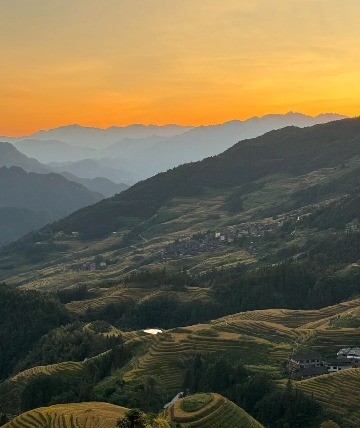
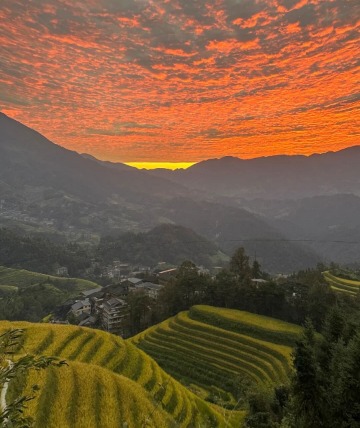
Sunrise
The sunrise at the Longji Rice Terraces usually occurs between 5:00 and 6:00 AM. The scene is breathtaking, with sunlight piercing through the clouds and creating beautiful beams of light. The terraced fields look even more stunning in the early morning light. From the viewpoint, the rice fields stretch out like a thousand-step ladder, leaving you in awe.
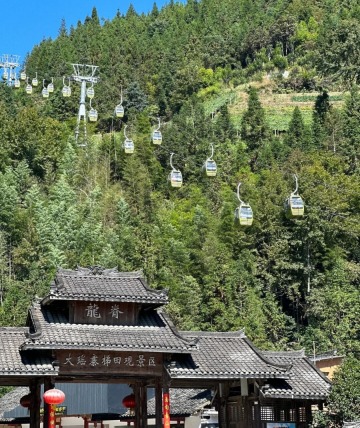
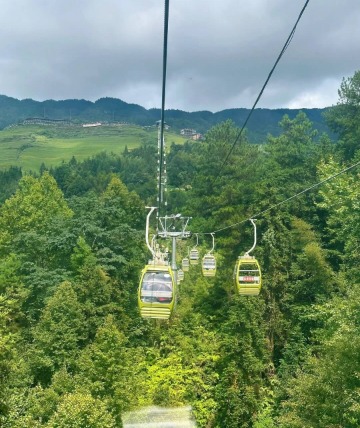
Cable Car
Riding the cable car offers a unique panoramic view, letting visitors look down on the vast Longsheng Rice Terraces of China. This aerial perspective highlights the layers and patterns of the terraces, and on certain days, the mist creates a magical, fairy-tale effect.
Performances at the Longji Rice Terraces
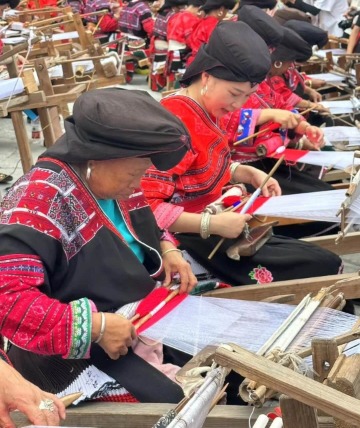
Clothes Drying Festival
The Clothes Drying Festival takes place on the 6th day of the 6th lunar month and is one of the most important festivals for the Hong Yao people, second only to the Spring Festival. During the festival, villagers hang their red clothes, floral skirts, and other garments out to dry on balconies, eaves, and windows, creating a beautiful scene. Villagers also showcase traditional textile skills like spinning, weaving, and embroidery. Visitors can get a close-up look and even learn these traditional crafts.
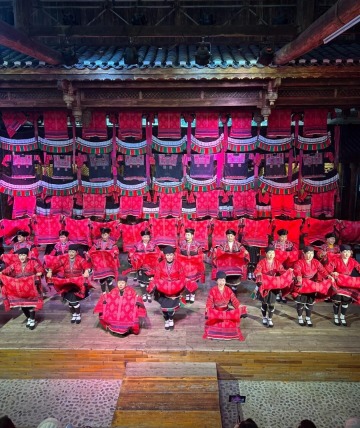
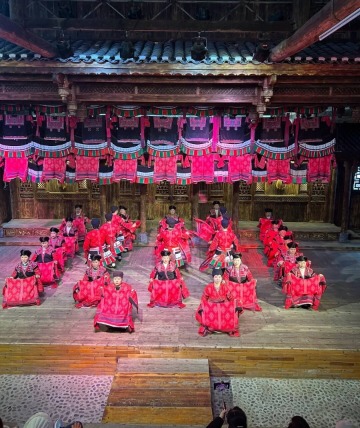
Huangluo Yao Village
One of the highlights of Huangluo Yao Village is the long hair performance. Visitors can watch women from the Hong Yao ethnic group showcase their long hair and learn about their hair care secrets. These women start growing their hair at the age of twelve or thirteen, using special natural methods to wash and care for it, keeping it shiny and black. The secret techniques passed down through generations are truly amazing.
Field Activities at the Longji Rice Terraces
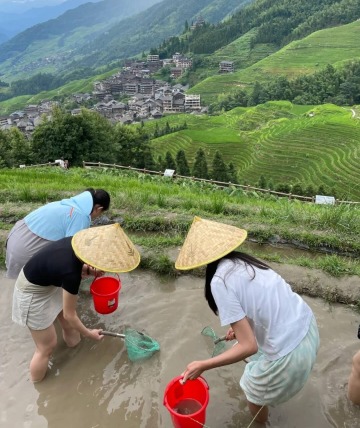
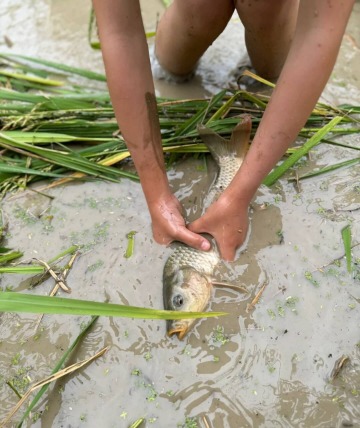
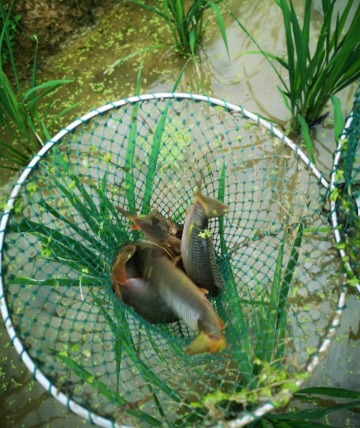
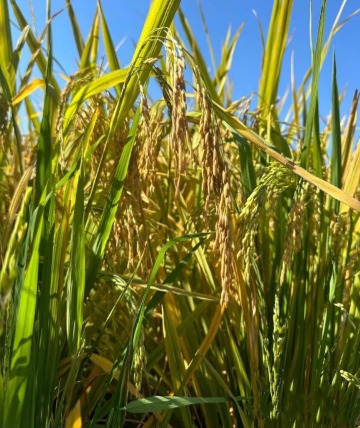
Catching Fish
At the Longji Rice Terraces, visitors can take part in a variety of hands-on activities, and one of the most popular is fish-catching in the rice fields. You can step into the soft, muddy fields without worrying about getting your clothes dirty. Kids especially enjoy running around and playing in the rice paddies, making it a fun experience for the whole family.
Food of the Longji Rice Terraces
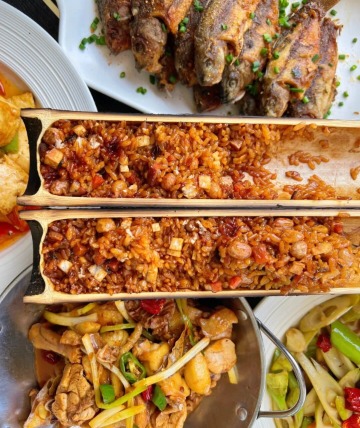
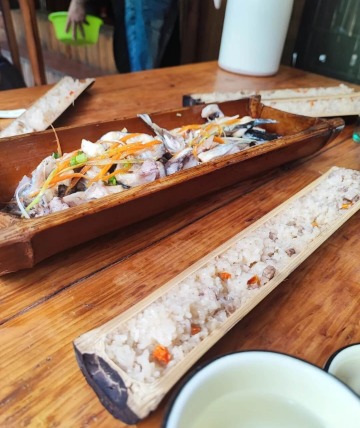
Bamboo Rice
The process of making bamboo rice is quite detailed. First, fresh bamboo is chosen, typically from the lush forests of Longji Mountain. Inside the bamboo, there’s a thin membrane that helps trap the aromas of both the bamboo and the rice as they cook. The rice used is local glutinous rice, and the water comes from the pure mountain springs of Longji. The rice, along with cured pork and just the right amount of mountain stream water, is placed inside the bamboo tube, which is then sealed tightly with a sweet potato. The result is a soft, sticky rice with a savory, aromatic flavor. The fat from the cured meat seeps into the rice, making each bite incredibly fragrant and delicious.
Accommodation at the Longji Rice Terraces
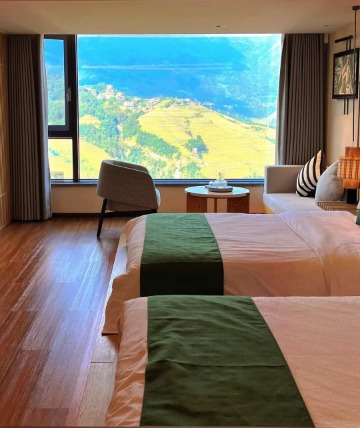
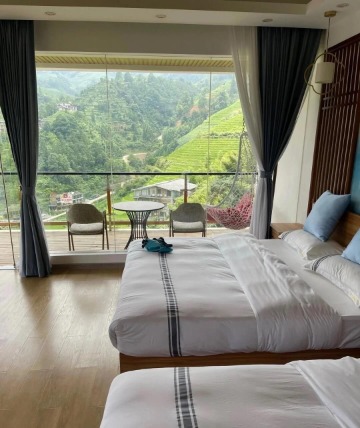
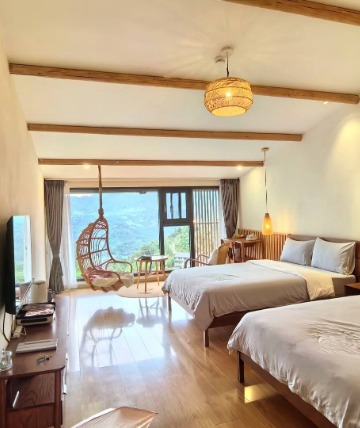
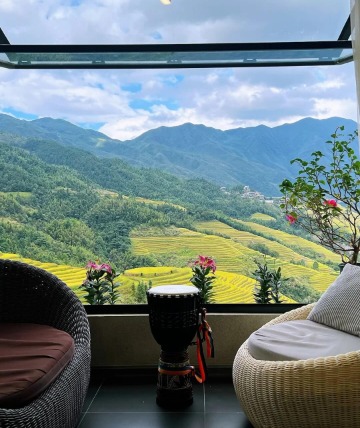
Most of the guesthouses at the Longji Rice Terraces are located near the viewpoints, such as in Dazhai Village, Tiantou Zhai, and Jinkeng Rice Terraces. Surrounded by mountains and terraced fields, each room offers a view facing the mountains where the sun rises, making it the perfect spot to enjoy the stunning landscape and catch the sunrise. Besides the beautiful scenery, these guesthouses also serve authentic, seasonal farm dishes like bamboo rice, bamboo chicken, cured pork, and rice field fish.
Hours & Fees
Hours
Open all day.
Best Time
- March to April: This is the best time to see the rapeseed flowers in full bloom. The terraces are covered in golden flowers, creating a stunning view.
- July to September: The rice begins to grow, and the terraces turn vibrant green. It’s a great time for sunrise and sunset photos.
- September to November: Especially in October, when the rice is ripe and the terraces are covered in golden grains, creating a spectacular golden landscape.
Fees
80 CNY (approximately 11 USD) per person.
FAQ About Longji Rice Terraces
1. Where is Longji Rice Terraces?
The Longji Rice Terraces are about 80 kilometers from Guilin and around 22 kilometers from Longsheng County. If you’re driving from Guilin, it takes about 1.5 hours to reach the ticket office, and then another 30 kilometers to get to the main scenic area. If you’re planning to drive, keep in mind that once you enter the area, the roads are winding mountain paths, so it’s not recommended for inexperienced drivers.
2. What is the altitude of the Longji rice Terrace?
The altitude of the Longji Rice Terraces ranges from 300 meters to 1,100 meters.
3. How were the Longji Rice Terraces formed?
The construction of the Longji Rice Terraces was an incredibly difficult process. Over 800 years ago, the first Zhuang and Yao people who arrived in Longji faced deep mountains and used the most primitive methods—slash-and-burn farming—to clear the land and create the first terraces. With strong willpower and wisdom, they overcame countless challenges and eventually shaped the spectacular terraced landscape we see today.
4. When do the rice fields at Longji Rice Terraces mature?
The rice at Longji Rice Terrace China typically matures between mid-September and late October each year. The best times to visit the terraces are in April-May and September-October. From March to May in spring, the terraces are flooded with water, reflecting the blue sky and creating a picturesque scene. In autumn, from September to November, the rice ripens, and the golden fields contrast beautifully with the blue sky, making for a stunning sight.
How Do Local Visitors Rate the Longji Rice Terraces?

Translation:
We had an amazing time at the Longji Rice terrace. Our driver and guide was really nice, he purchased all tickets for us, gave un detailed information, showed us beautiful places and took us for a delicious bamboo chicken lunch. We warmly recommand this trip!

Translation:
We rented a sightseeing car with a local guide on board. He recommended we check out the Thousand-Step Ladder. The Longji Rice Terraces in the fall were absolutely stunning – everywhere you looked, there were golden rice fields. After we got off the car, I paid 30 yuan to rent a local ethnic costume for an hour to take some photos. I noticed every sightseeing car has a local guide, and you can even go to their home to try some local food. (Oh, and make sure to get the guide’s phone number – it’s easy to get lost around here!)
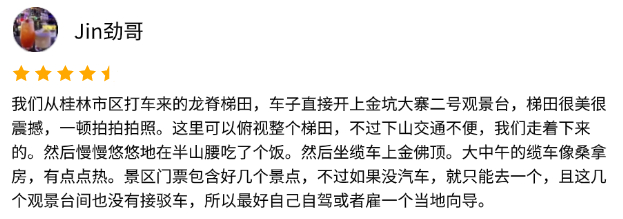
Translation:
We took a taxi from downtown Guilin to the Longji Rice Terraces. The driver took us straight up to the Jin Keng Dazhai No. 2 Viewing Platform. The terraces were stunning – so beautiful and impressive. We spent some time taking tons of photos. From here, you can get an amazing view of the whole terrace, but getting back down is tricky. So, we ended up walking down. Afterward, we had a nice, leisurely meal at a restaurant halfway down the mountain. Then we took a cable car up to Golden Buddha Peak. It was around midday, and the cable car felt like a sauna – a bit hot. The park entrance ticket includes several attractions, but without a car, you can only visit one. Plus, there are no shuttle buses between the viewpoints, so it’s best to either drive yourself or hire a local guide.
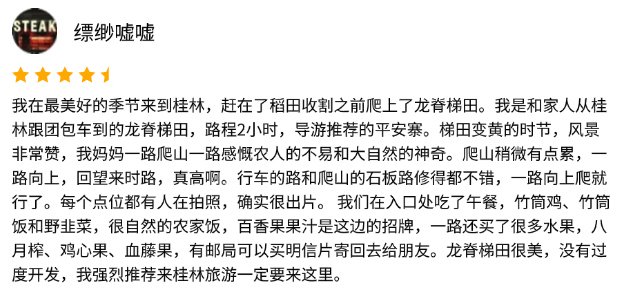
Translation:
I visited Guilin during its most beautiful season, just before the rice fields were harvested, and made my way up to the Longsheng Rice Terraces. My family and I took a guided tour with a private car from Guilin, which took about two hours. The guide recommended we go to Ping’an Village. It was the season when the terraces were turning yellow, and the scenery was absolutely stunning. My mom kept commenting on how hard farmers’ lives must be and how amazing nature is as we climbed the mountain. The hike was a bit tiring, and as we climbed higher, the view behind us kept getting more breathtaking. The roads and the stone paths up the mountain were in good shape, so it was pretty easy to just keep going up. At each spot, there were people taking photos – it really is a photographer’s dream. We had lunch at the entrance, enjoying local dishes like bamboo chicken, bamboo rice, and wild chives – simple, hearty farmhouse food. Passion fruit juice is a local specialty here, and we also bought a lot of fruit along the way, like August plum, chicken-heart fruit, and blood vine fruit. There’s even a post office where you can send postcards to friends. The Longji Rice Terraces are incredibly beautiful, and it hasn’t been overly commercialized. I highly recommend that anyone visiting Guilin make sure to come here.

Translation:
You definitely need to pick the right season! When I went, it was right in the middle of Guilin’s rainy season, so the weather was unpredictable – cloudy one moment, sunny the next. The fog on the mountaintop also made the views less clear. As for the local food, the mountain frogs are really fresh, and if you’re up for it, I’d say give them a try – they’re actually pretty delicious. But the so-called bamboo tube fish… yes, they’re freshly caught, but honestly, the taste is pretty average, with a strong earthy flavor. If you’re traveling independently, just a heads-up: if you go in the fall, try to avoid rainy days, because the weather can really impact your experience.

